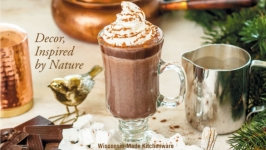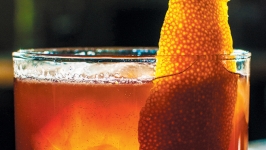Wisconsin-Barrel-Aged Beers
Wisconsin’s Aging Our Beers
One of the most inspiring and enigmatic characteristics of beer is its inherent ability to evolve, both during and well beyond fermentation. With time, certain flavors erode and others begin to assert themselves as the beautiful liquid matures. But few things can have a more profound impact on a beer than barrel aging. The concept is rather basic. Add beer to a wooden barrel, let it sit for a period of time, blend and package. But as I’ve come to learn from some of Wisconsin’s finest brewers, barrel aging is a fickle art consisting of trial, error, understanding, creativity, patience and vision. Regardless of whether the barrels are being used primarily for bacterial fermentation or to directly impart flavors from the wood, barrel aging is a process that positions the ingenuity of humans versus the non-negotiable forces of nature.
Hinterland Brewery in Green Bay started playing with barrel aging in 1999. And like any other new venture, building a barrel-aging program posed some immediate growing pains, such as unique spatial requirements, finding and transporting barrels, and implementing consistency throughout processes. “Our biggest initial challenge was getting the barrels to the brewery. We did not have the issue of finding and securing the barrels, it was getting them to the brewery at a reasonable cost,” says Joe Karls, head brewer at Hinterland. “Today, it is just the opposite. Finding barrels can be the challenge.”
In addition, tinkering with various types of barrels is paramount in determining what the desired beer will taste like, whether it’s used oak having previously stored spirits (most commonly bourbon) or wine, or new oak barrels with various types of char. Each type of wood or distinction of a barrel will impart drastically different flavors. Even after 17 years, Hinterland continues to experiment and tweak, always searching for something new and captivating to enhance their beers.
Eighty-five miles west of Green Bay is the small town of Amherst, home to Central Waters Brewing. Like Hinterland, Central Waters was a pioneer in Wisconsin-beer-barrel aging, having kicked off their program in 2001. And while Central Waters’ program is now the biggest in the state, its success was not overnight, and not without some constant headwinds, one of which was—and still is—the element of time. “A new barrel-aged beer can take anywhere from one to five years to make,” reflects Anello Mollica, co-owner of the iconic brewery. So, if an experimental batch of barrel-aged beer takes 1–2 years before it’s ready for evaluation, moving a successful batch into production means waiting another 1–2 years before the beer is released to the public. Suffice to say, it takes a massive amount of patience and nurturing to release just one barrel-aged beer onto the market. “It can be a long process,” adds Mollica. “The biggest thing is time. Learning to forget about it for a few years with a beer like Black Gold. We are brewing beers now for release in 2020.”
In addition to the natural obstacle of time, quality control is another recurring theme when discussing barrel aging, and virtually every brewery that I talked to reflected this constant challenge. Beyond consideration of just storage temperature and barrel generation— that is, how many times you plan to use the vessels—wooden barrels themselves can host a number of microorganisms that contribute significantly to a beer’s flavor. Some of those contributions are intentional inoculations, as is the case with bacteria in some sour and wild-fermented beers, to purposefully enhance tartness or flavor complexity. Other effects are an unanticipated infection that can taint a beer and destroy it. “Bugs have a mind of their own,” says Marc Buttera, owner of O’so Brewing in Plover, WI. “You can’t really control what is going on in the barrel, you can only attempt to control the chaos. Also the phases that a beer goes through during aging are pretty interesting, depending on what organism is working at the time.”
As the landscape in the industry becomes more competitive, the focus on quality and consistency becomes an even more critical component to differentiate. While even the most adept and knowledgeable brewers have undoubtedly experienced infection or undesirable results, it’s their resiliency and ability to find new methods to improve quality that sets a brewery and their brand apart. Matt Krajnak of Lakefront Brewery provided some insight into their quality process. “Our head brewer, Luther, and our quality control manager, Tim, will take random sample sets from different barrels on a monthly basis. Luther checks the flavor and Tim does the lab tests, measuring alcohol content, color and turbidity,” explains Krajnak. But even with such meticulous processes in place, there really is no practice to prevent against nature taking its course. It’s man versus wild.
Since barrel-aged beer can span the entire spectrum of styles, another crucial element is understanding how different beers respond during the aging process. Lighter and more ethereal beers, such as wild ales, need less time in the barrel to absorb the desired idiosyncrasies than do bigger, audacious beers, like imperial stouts. But the ultimate result of this tremendous labor of love is a selection of aged beers for every consumer’s palate, from the caramel and vanilla notes of a bourbon-barrel-aged doppelbock to the tart and fruity layers of an oak-aged sour, and everything between. In the end, it’s about keeping an open mind, perhaps taking a step into new territory and exploring the bottom barrel-aged beauties that await you.
5 Wisconsin-Barrel-Aged Beers to Imbibe
(Here are few tasting notes to get you started!)
Hinterland Bourbon Barrel Aged Doppelbock. Maple, vanilla and some oak on the nose, caramel and maple coat the tongue with a finish of dark fruit and warming bourbon.
Lakefront Brandy Barrel Aged Imperial Pumpkin Ale. Bouquets of brandy and spice followed by decadent flavors of nutmeg, cinnamon, vanilla and pumpkin, fade into a balanced brandy-and-sweet-caramel finish.
O’so Wease the Juice Barrel Aged and Brett Blended Cherry Sour. Aromas of oak and vibrant fruit, flavors of funky wild yeast, tart cherry and underripe banana. Plus, a finish that is pleasantly puckering and effervescent.
Central Waters Black Gold Bourbon Barrel Aged Imperial Stout. Rich chocolate and dark, roasted coffee aromas, with a flavor profile of dark chocolate and hints of vanilla with a rounded and restrained bourbon finish.
Milwaukee Brewing Louie’s Resurrection Bourbon Barrel Aged Amber Ale. Bourbon and roasted malt aromas transition to ripened dark fruits and vanilla on the palate with a nicely muted oak finish.







